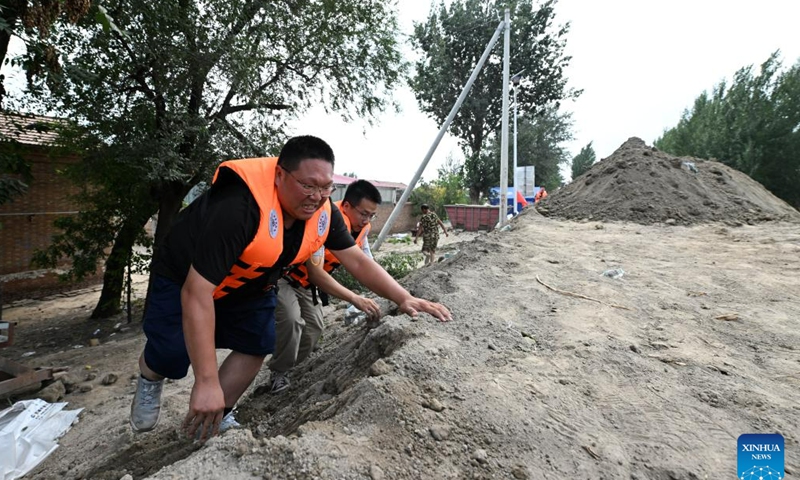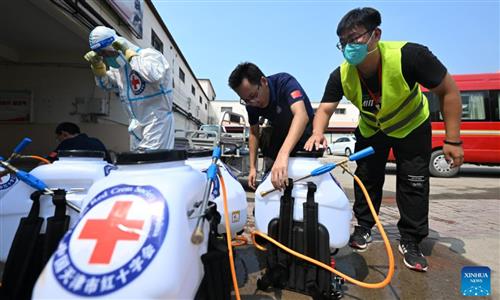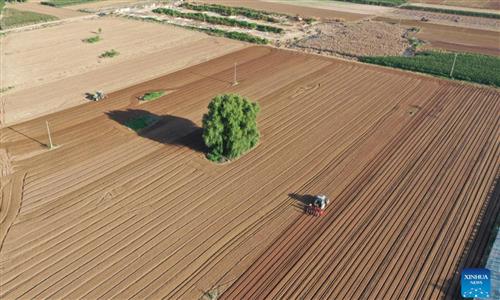Weaknesses in monitoring, forecasting exposed during N China’s worst flood: Ministry of Water Resources

Anti-flood personnel patrol a dike in Jinghai District, north China's Tianjin Municipality, Aug. 10, 2023. Local authorities have continued the flood control and disaster relief efforts at the Taitou section of the Daqinghe River in Jinghai District of north China's Tianjin Municipality, preparing the district for any emergency.(Photo: Xinhua)
The worst flood that hit the Haihe River Basin in North China since 1963 has exposed weaknesses in monitoring and forecasting capabilities for floods, said China's Ministry of Water Resources (MWR) on Monday.
From July 28 to August 1, some 22 rivers in the basin experienced above-warning level flooding, and eight rivers reported the largest floods ever recorded, said MWR officials at a news conference. The disaster has caused 61 deaths, and millions of people were impacted.
At present, the water levels in active flood storage and retention areas within the basin are gradually retreating and residents are gradually returning home, officials said.
Liu Weiping, a vice minister of the MWR, said reservoirs in the region have played a key role. Eighty-four large and medium-sized reservoirs were mobilized to intercept 2.85 billion cubic meters of floodwater, while the comprehensive role of the basin's flood control system was fully utilized to minimize the impact and losses caused by the floods.
These reservoirs have prevented 500,000 hectares of farmland in 24 townships from being flooded, said Liu. More than 4.6 million people would have been evacuated if not for the reservoirs.
Although the flood control system has played an important role in combating this flooding in the Haihe River Basin, which is the major water system with an area of about 320,600 square kilometers in North China, many loopholes have been exposed, said MWR officials.
The nation is still relatively weak in terms of monitoring and forecasting floods, said Zhang Xiangwei, an official from the Department of Planning and Programming of the MWR.
Weaknesses include insufficient flood storage capacity in some the rivers, insufficient flood capacity to meet requirements, lagging behind in the construction of stagnant flood storage areas and inadequate flood entry and exit facilities, Zhang said.
These weaknesses are particularly evident in the forecast of small river floods, which needs to be further improved both in meteorological and hydrological terms, Ma Jun, director of the Beijing-based Institute of Public and Environmental Affairs, told the Global Times on Monday.
Ma noted that the disruption of the network has led to transmission interruptions at some monitoring stations, which had a great impact on accurately predicting the trend of floods.
Given these weaknesses, Zhang said that the MWR will further strengthen the integrated management of the Haihe River Basin in collaboration with relevant departments and local authorities.
Ma called for a reassessment of the risk of meteorological disasters such as torrential rain and flash floods in the context of climate change, as well as corresponding urban planning.
In response to the floods in the Haihe River Basin, the MWR has strengthened technical guidance and provided support for post-disaster reconstruction. A total of 26 working groups and expert teams have been dispatched to provide targeted guidance of flood prevention and risk management efforts.
Moreover, China's Ministry of Finance has allocated 1.15 billion yuan ($157.35 million) to support the timely repair of water conservancy facilities in the Beijing-Tianjin-Hebei region.
Additionally, 1.5 billion yuan for compensation in flood storage and detention areas has been allocated to support the affected areas and people in quickly restoring production and their livelihoods, said Liu.
According to media reports, the post-disaster reconstruction in the Beijing-Tianjin-Hebei region is being carried out in an orderly manner. Beijing's Mentougou district is accelerating cleaning of the Yongding River to ensure subsequent rainfall flood flow is at safe levels, said Zhang Hewei, an official from the Mentougou district government.
A total of 16 teams from institutes of city planning and design have been sent to the Mentougou district to analyze the occurrence of geological disasters and the situation in terms of risk prevention and control.
Some 15,000 grassroots officials and agricultural technicians in Hebei have been organized to assist farmers in post-disaster production recovery, as well as 12 robotic vehicles in the city of Zhuozhou have been deployed for underground garage dredging, according to media reports.
Noting that the flood season is still ongoing, with severe and complicated floods and droughts still expected, Liu said the ministry will continue to strengthen all prevention measures.



